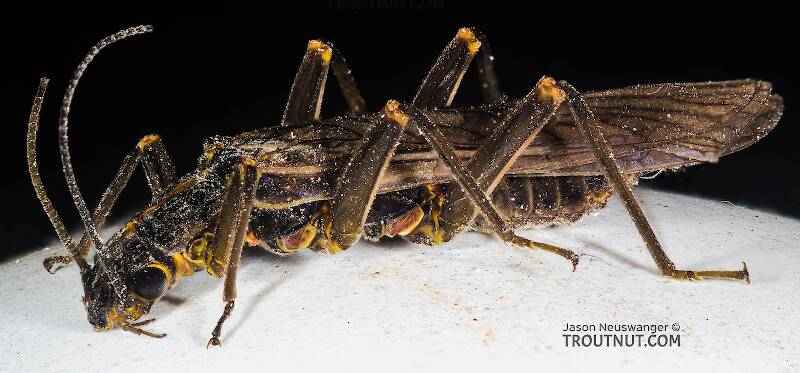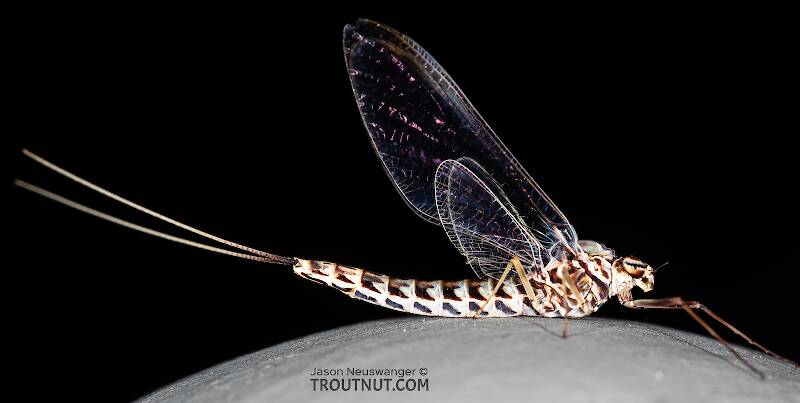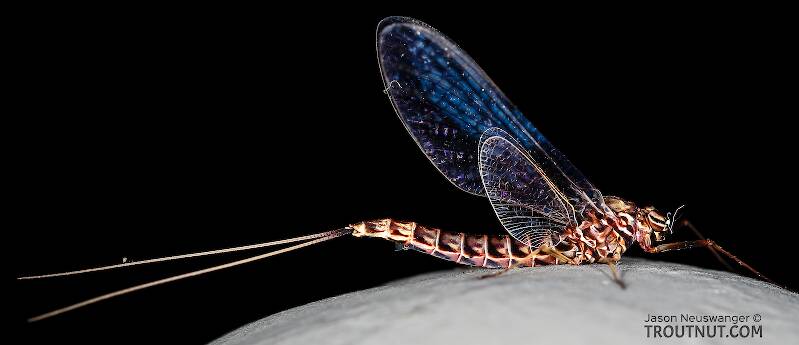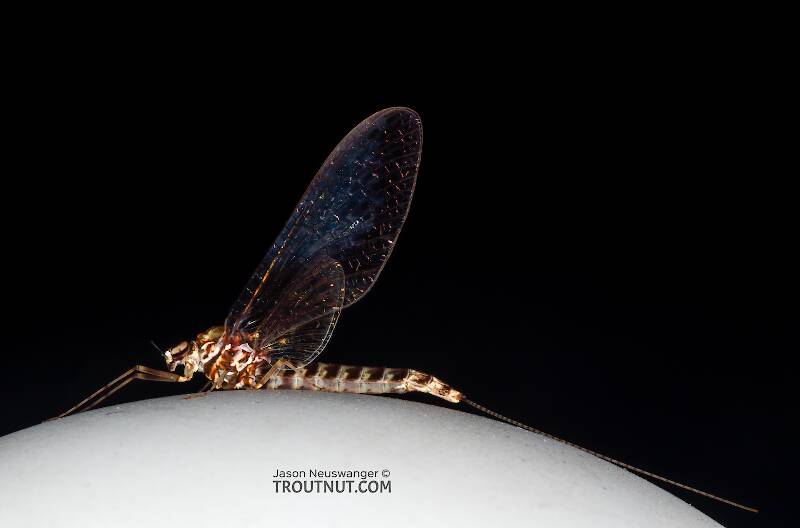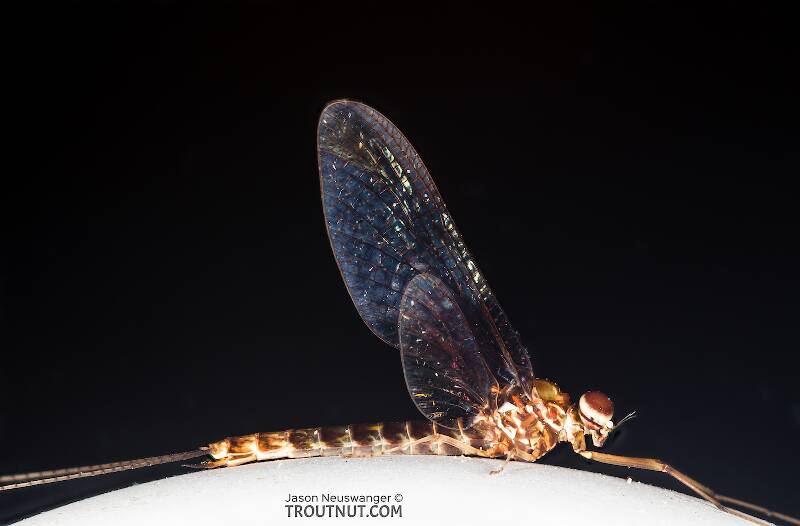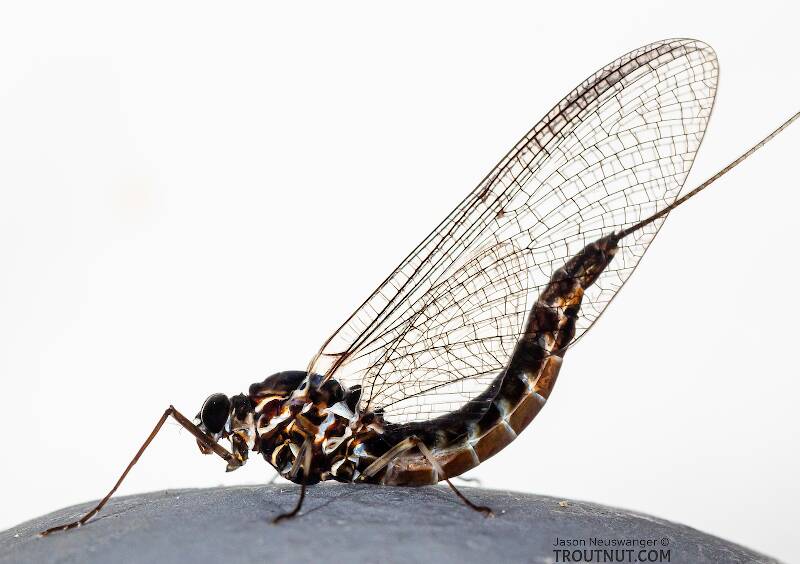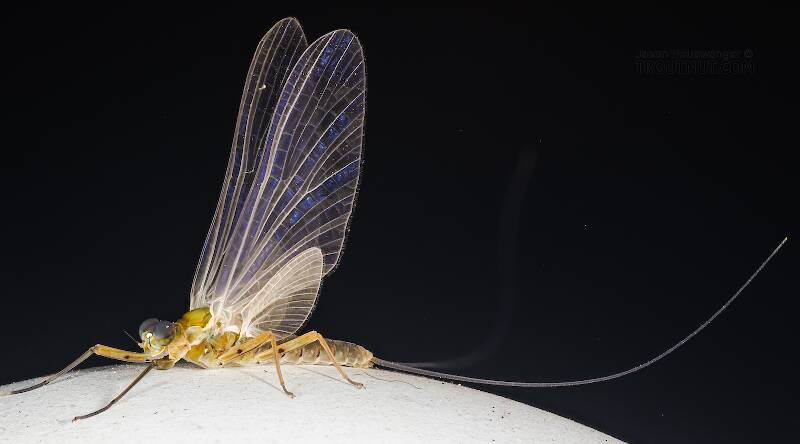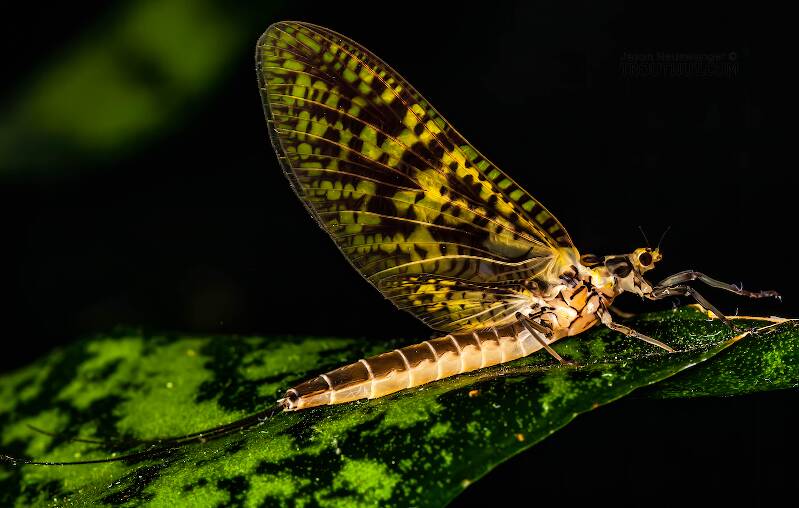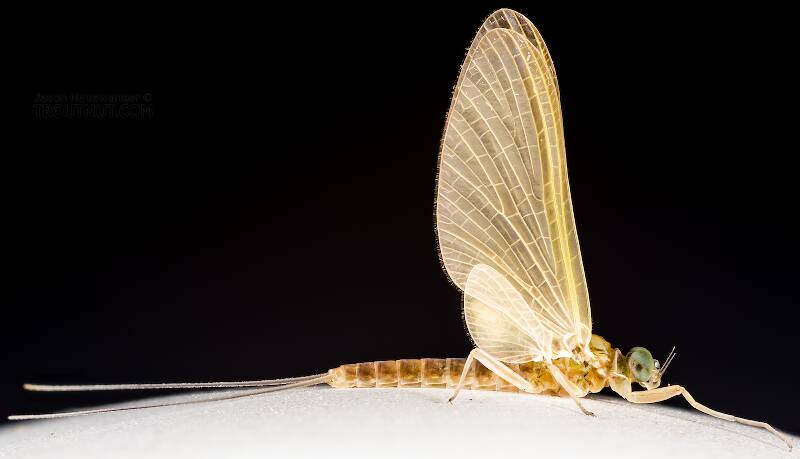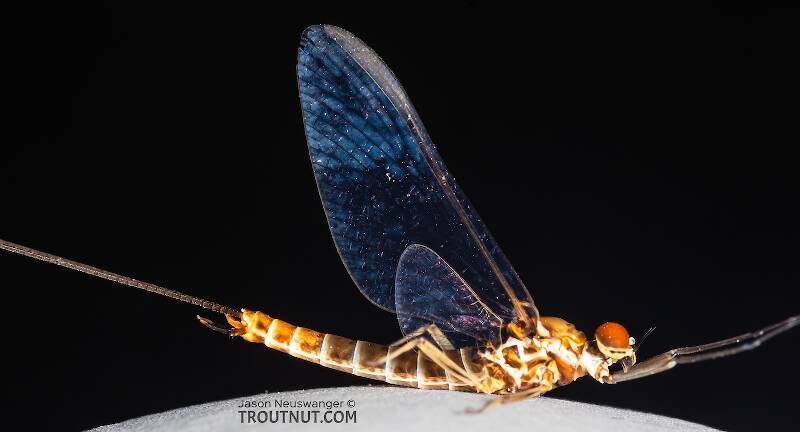
Blue-winged Olives
Baetis
Tiny Baetis mayflies are perhaps the most commonly encountered and imitated by anglers on all American trout streams due to their great abundance, widespread distribution, and trout-friendly emergence habits.
Featured on the forum

Troutnut is a project started in 2003 by salmonid ecologist Jason "Troutnut" Neuswanger to help anglers and
fly tyers unabashedly embrace the entomological side of the sport. Learn more about Troutnut or
support the project for an enhanced experience here.
Identification: Easy Angler's Key to Common Adult Mayflies, Couplet 10
Identification: Easy Angler's Key to Common Adult Mayflies, Couplet 10
| Option 1 | Option 2 |
|---|---|
Intercalary veins between vein CuA and CuP in the forewing consist of a series of small veinlets, often forking or curved, that connect vein CuA directly to the hind margin of the wing 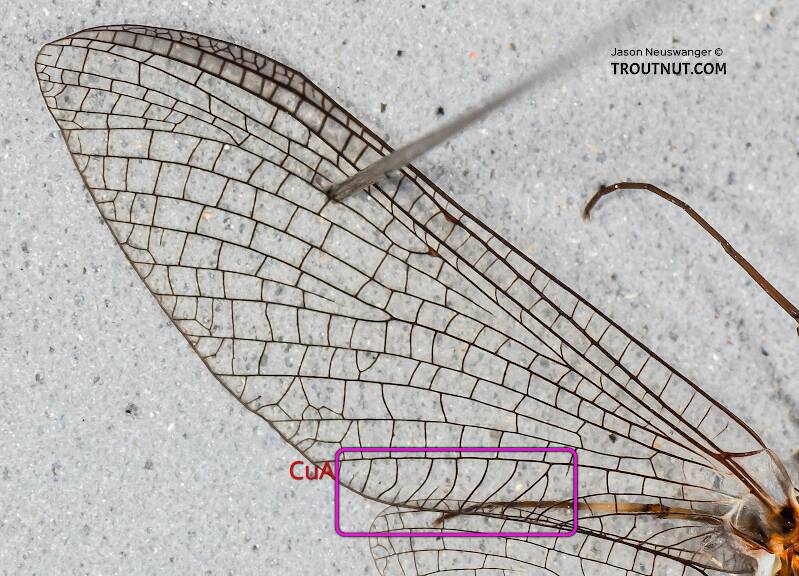
| Intercalary veins in this region variable, but not as at left 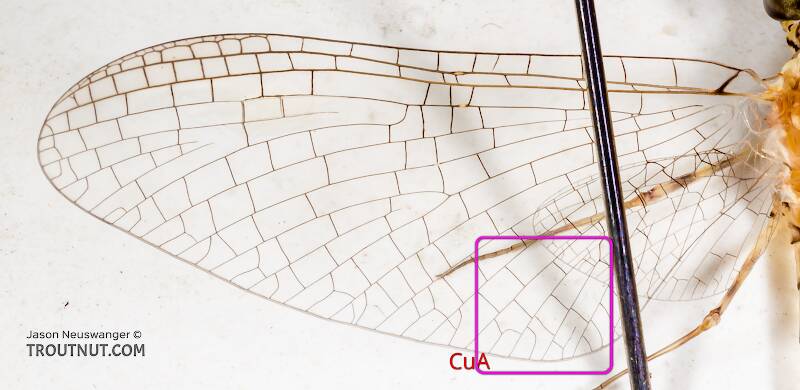
|
| Remaining families: Ameletidae and Siphlonuridae | Remaining families: Ephemeridae and Heptageniidae |
5 Example Specimens | 5 Example Specimens |
| Go to Couplet 11 | Go to Couplet 12 |
The current couplet is highlighted with darker colors and a icon, and couplets leading to this point have a icon.
Leads to Couplet 5:
- Hind wings absent
- Body length 2–7 mm (hook sizes 20 & smaller)
Couplet 5
Leads to Couplet 6:
- Hind wings present
- Body length usually > 7 mm (hook sizes 18 & larger)
Couplet 6
Leads to Baetiscidae
(Baetisca):
(Baetisca):
- Abdomen mostly very thick, then tapering off rapidly in the last 4 segments
- Hind wing rounded, almost circular
- Wings of dun blotchy, wings of spinner clear
- Body length 7–10 mm (hook sizes 14–18)
- Fairly uncommon
Leads to Couplet 8:
- Abdomen thinner in proportion to the rest of the body; more "normal" mayfly shape
- Hind wing more oblong and often less rounded, more angular
- Wings variable
- Length variable
- Very common
Couplet 8
Leads to Leptohyphidae
(Tricorythodes):
(Tricorythodes):
- Abdomen black, dark brown, or olive green
- Wings without a black stripe on the leading edge, although thick veins there may be darker than the rest of the wing
- Male tails around twice the length of the body
- Very common on many trout streams
Leads to Ephemeridae
(Ephemera):
(Ephemera):
- Wings usually with irregular, blotchy marks
- Very large bodies typically at least 15 mm long (hook size 8 or larger)
- Body with a very elongated abdomen, almost serpentine; the "drake" shape characteristic of their long-bodied burrowing nymphs
- Hind wing large, typically one third to one half the length of forewing
Leads to Couplet 7:
- Wings of dun usually shades of uniform gray; wings of spinner usually clear
- Medium-large to small bodies typically less than 15 mm long (hook size 10 or smaller), although the largest species can just reach hook size 8
- Body with more "average" mayfly proportions, not exceptionally elongated
- Hind wing size variable, but typically about one quarter to one third the length of forewing
Couplet 7
Leads to Ephemerellidae:
- Hind wings with a distinct costal angulation, i.e. a small, rounded bump in the front edge
Leads to Leptophlebiidae:
- Hind wings without costal angulation, except in some species rarely found on trout streams
- Continue to Couplet 2 of the Key to Genera of Male Leptophlebiidae Spinners to easily narrow it down one step further.
Leads to Polymitarcyidae
(Ephoron):
(Ephoron):
- All legs of female, and all except front legs of male, feeble and non-functional
Leads to Couplet 9:
- Legs normal and fully functional
Couplet 9
Leads to Isonychiidae
(Isonychia):
(Isonychia):
- Forelegs dark; middle and rear legs pale
Leads to Couplet 10:
- All legs roughly similar to each other in color
Couplet 10
Couplet 10 (You are here)
Leads to Couplet 11:
- Intercalary veins between vein CuA and CuP in the forewing consist of a series of small veinlets, often forking or curved, that connect vein CuA directly to the hind margin of the wing
Couplet 11
Leads to Couplet 12:
- Intercalary veins in this region variable, but not as at left
Couplet 12
Leads to Siphlonuridae
(Siphlonurus):
(Siphlonurus):
- Eyes of male with a pale, horizontal band
- Hind wings with a rounded costal angulation
Leads to Ameletidae
(Ameletus):
(Ameletus):
- Eyes of male without a pale, horizontal band
- Hind wings with a pointed costal angulation
Leads to Ephemeridae
(Hexagenia):
(Hexagenia):
- The largest North American mayflies, with typical body lengths greater than 17 mm
- Body with a very elongated abdomen, almost serpentine; the "drake" shape characteristic of their long-bodied burrowing nymphs
- Hind wing large, typically almost half the length of forewing
Leads to Heptageniidae:
- Body lengths very from small to medium-large, but almost always less than 17 mm
- Body proportions may have a very "average" mayfly shape Alternatively, in many cases, the head, legs, or body might appear somewhat flattened and splayed-out, reflecting the flattened profile of their clinger-type nymphs
- Hind wing size variable, typically around one quarter to one third the length of forewing
Start a Discussion of this Couplet
Families excluded
These families of Ephemeroptera are not included in this key: Metretopodidae, Behningiidae, Neoephemeridae, Potamanthidae, Acanthametropodidae, Ametropodidae, Arthropleidae, Oligoneuriidae, Pseudironidae, Euthyplociidae, Palingeniidae
Description of this key
This key is helps identify common adult mayflies using characteristics that are relatively easy to see and interpret. It omits many rare mayflies and uses characteristics that aren't all 100 % reliable, but it should put anglers close to the right answer most of the time. However, when accuracy is critical, you should use the full Key to Families of Mayfly Duns and Spinners.


